The caterpillars found in Oklahoma have long fascinated us with their wondrous transformation into majestic butterflies and moths. These fragile insects captivate our hearts with their intricate biology and fascinating behaviors. Delving into the classification of caterpillars not only helps us identify them, but also offers valuable insights into their dietary preferences and the places they call home. Embark with us on an extraordinary journey into the mesmerizing world of caterpillars, where we’ll uncover their exquisite anatomy, unique leg arrangements, and beguiling behaviors.
Caterpillar Biology and Classification
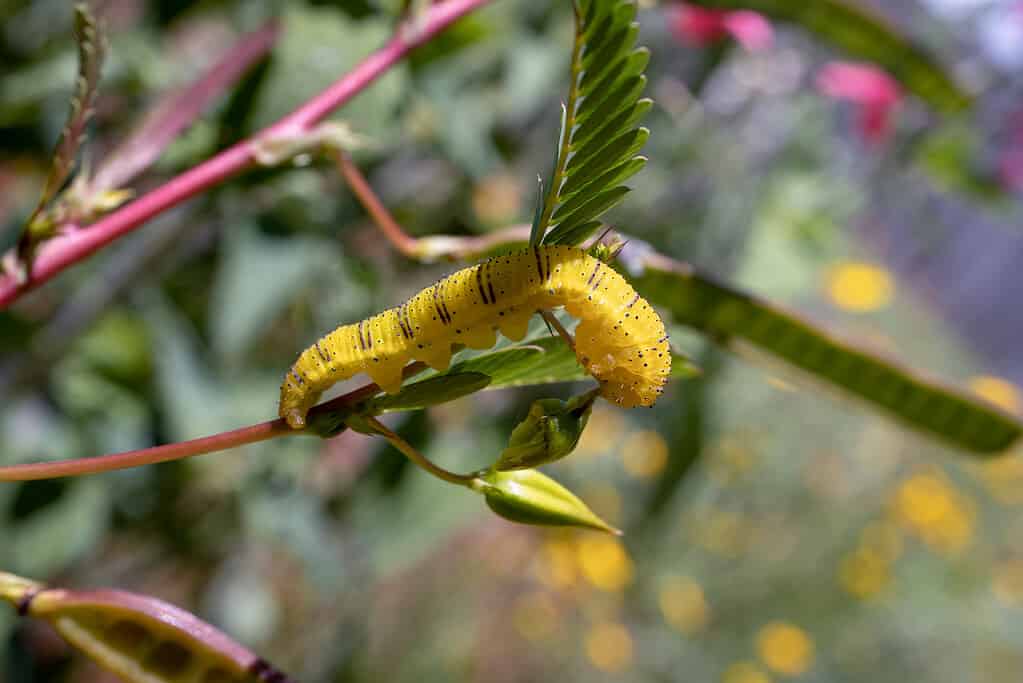
Cloudless sulphur caterpillars are found in glades, gardens, and open spaces in Oklahoma.
©DrWD40/ via Getty Images
Caterpillars have segmented bodies with distinct parts like the head, thorax, and abdomen, which each serve unique purposes. The head contains sensory organs for perceiving the environment and finding food. The thorax controls movement, and the abdomen handles digestion, reproduction, and physiological functions.
Caterpillars have varying leg arrangements, including prolegs on the abdomen for climbing and grasping. Some species use defense mechanisms like spines to discourage predators. Many caterpillars blend with their environment by mimicking leaves. But another giant question that is common, is, how can we tell if it will grow into moths or butterflies?
A Moth or Butterfly?
Butterflies and moths are fascinating creatures that belong to the insect order Lepidoptera, a name derived from the Greek term “scale-winged”. These extraordinary organisms share common traits, including four delicate wings adorned with minuscule scales. However, it is important to note that there are distinctive characteristics that set these two taxonomic groups apart.
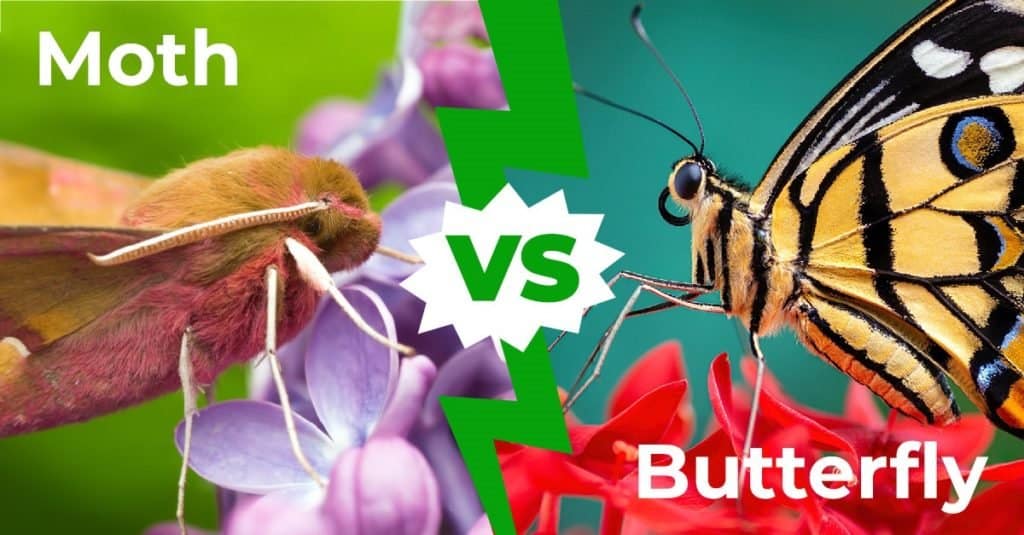
Butterflies and moths have fascinating distinctions in wing positioning. When at rest, butterflies elegantly fold their wings vertically over their backs, while moths opt to keep their wings flat or spread out horizontally. Antennae offer intriguing contrasts as well: butterflies possess slender and elongated antennae with club-like tips, while moths display feathery antennae with a thicker, comb-like appearance. Butterflies employ vibrant hues to attract mates and deter predators, whereas moths typically exhibit more subdued tones to blend in seamlessly during nocturnal hours. While butterflies are primarily active during the day, soaring in the sunlight, moths gracefully embrace the night as their own domain. It’s important to acknowledge that exceptions exist, such as the luna moth, which defies conventions with its awe-inspiring size and striking colors yet remains active during the day.
Swallowtail Caterpillars Found in Oklahoma
Oklahoma is home to a rich variety of caterpillars, with a total of 133 species within its borders. These caterpillars belong to diverse families, including Noctuidae (owlet moths), Erebidae (tiger moths), Lasiocampidae (tent caterpillars), and Saturniidae (silkworm moths). Out from among them stands eight distinct caterpillar species that belong to the stunning “swallowtail” group of butterflies. Continue reading, and we’ll cover the “swallowtail” group of caterpillars found in Oklahoma.
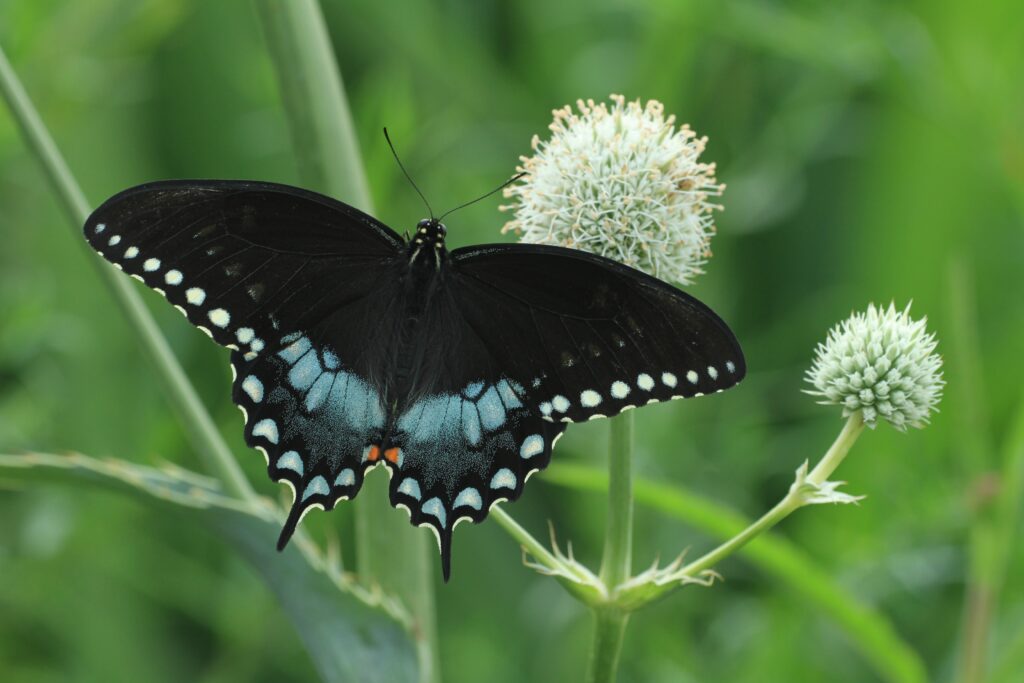
The spicebush swallowtail is just one of the beautiful species of swallowtail butterflies in Oklahoma.
©Kevin Collison/Shutterstock.com
Swallowtail butterflies derive their name from the bird-like appearance of their unique hind wings. When at rest, the forked shape of their wings becomes remarkably conspicuous, setting them apart from other species. This family encompasses over 500 species globally, renowned for their considerable size and vibrant colors. Some species even bear tails on their hind wings. While other butterflies, such as the monarch, viceroy, and comma, also possess tails, it is the swallowtail that enjoys the foremost position. Hence, they are commonly referred to as “swallowtail” butterflies. Beyond their captivating tails, these butterflies enthrall us with their intricate patterns and exceptional long-distance flights.
1. Black Swallowtail Caterpillar (Papilio polyxenes)

Some enthusiasts raise these caterpillars in captivity simply to witness their enchanting metamorphosis.
©Graphicato/Shutterstock.com
The black swallowtail caterpillar, found in Oklahoma, measures about 2 inches in length when mature. This remarkable creature possesses a clever defense mechanism: the ability to secrete a distasteful liquid, effectively discouraging any appetite its predators might have for it. As it progresses through its life cycle, the caterpillar’s appearance undergoes a captivating transformation. Initially adorned with a black body and vibrant yellow stripes, it eventually transitions into a stunning shade of green, adorned with delicate yellow spots. The caterpillar skillfully camouflages itself by securing its chrysalis to a leaf, blending seamlessly with its surroundings through a combination of green and brown tones.
2. Eastern Tiger Swallowtail Caterpillar (Papilio glaucus)
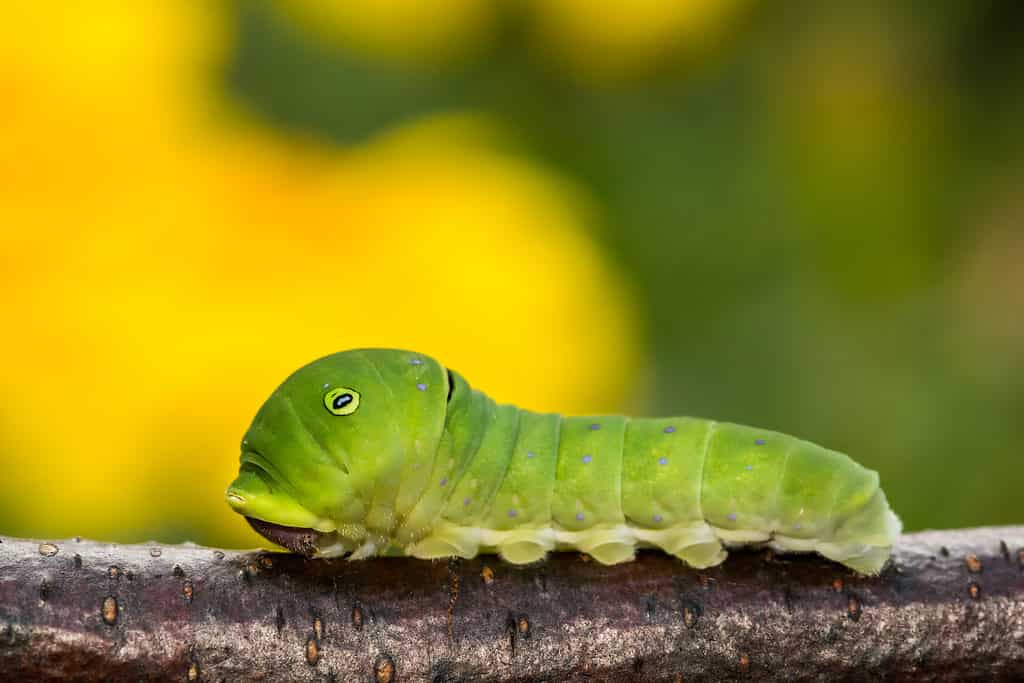
The aptly named “tiger swallowtail” is an iconic species found all over the United States.
©Jay Ondreicka/Shutterstock.com
The eastern tiger swallowtail caterpillar is another swallowtail caterpillar found throughout Oklahoma. It typically reaches lengths of up to 2 inches when fully grown. Eastern tiger swallowtail caterpillars feed on a variety of plants, mainly the leaves of cherry, apple, birch, willow, and tulip trees. When they reach adulthood, they become a beautiful yellow and black butterfly with a wingspan of up to 5 inches. Eggs are laid on the undersides of leaves and hatch within a week or two. As they grow, the caterpillars shed their skin multiple times until they reach full maturity. They then form a chrysalis and turn into adults in two to three weeks. Adults feed on nectar from flowers such as zinnias, phlox, and goldenrod.
3. Giant Swallowtail Caterpillar (Papilio cresphontes)
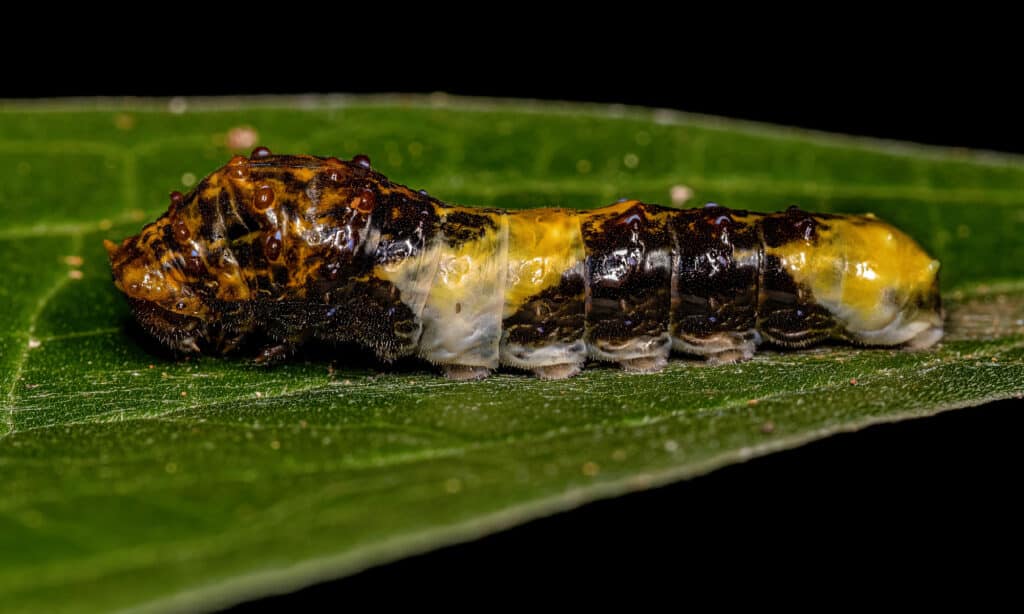
A fascinating creature, the giant swallowtail caterpillar has a lot to offer in terms of intrigue and wonder.
©iStock.com/ViniSouza128
The giant swallowtail caterpillar in Oklahoma is not your average insect. It is among the largest butterfly caterpillars in North America! This unique caterpillar is about 3 inches long when it reaches maturity. But what really sets it apart are its false legs, or prolegs, and the sticky secretion it secretes to deter predators. Its ability to blend in with its surroundings is truly remarkable. It evolved patterns and colors to resemble a bird’s droppings so convincingly that it avoids being eaten! When it feels threatened, this caterpillar will arch its back and expose false eyespots. The resulting illusion makes it appear much larger — like a cobra will do, for example.
4. Pipevine Swallowtail Caterpillar (Battus philenor)

Pipevine swallowtail caterpillars are black with orange spikes.
©Sundry Photography/Shutterstock.com
The pipevine swallowtail caterpillar is a remarkable caterpillar found in Oklahoma. This large and colorful caterpillar has an intricately armored body with black and orange spikes that make it stand out against its surroundings. But there is much more to this critter than meets the eye. This caterpillar has evolved to become a master of disguise, easily hiding among plants of the pipevine family, including plants like Dutchman’s pipe, Virginia snakeroot, and false rue. Its unique coloring and shape help it blend in with the foliage of its host plants, making it exceedingly difficult for predators to spot. If you ever find yourself lucky enough to stumble upon one of these fascinating creatures, take a moment to appreciate the intricate web of natural selection that has brought it to life.
5. Spicebush Swallowtail Caterpillar (Papilio troilus)
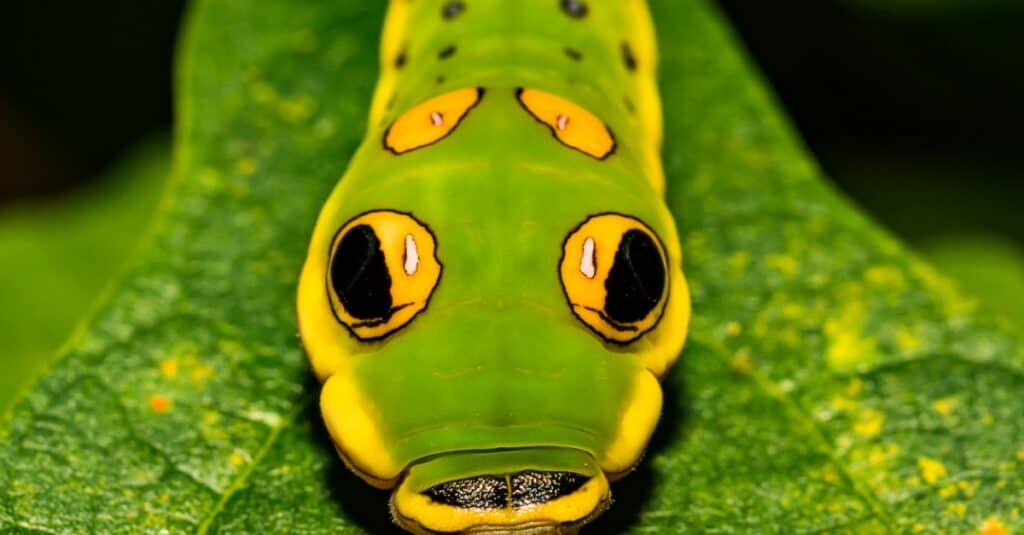
These fascinating creatures effortlessly camouflage themselves within their surroundings.
©iStock.com/JasonOndreicka
The spicebush swallowtail caterpillar is a fascinating creature that can be found in the eastern half of Oklahoma and many other parts of the United States. On one hand, it’s hard to miss these caterpillars due to their unique, chubby green bodies, with yellow and black spots running down their body. However, despite their striking appearance, these creatures actually blend in perfectly with their environment — they are often found on the underside of leaves, where they feast on the foliage of the spicebush plant. Although they may seem like just another insect, the spicebush swallowtail caterpillar plays an important role in the ecosystem as a food source for birds and other animals. Observing these creatures in their natural habitat is a truly awe-inspiring experience.
6. Zebra Swallowtail Caterpillar (Protographium marcellus)
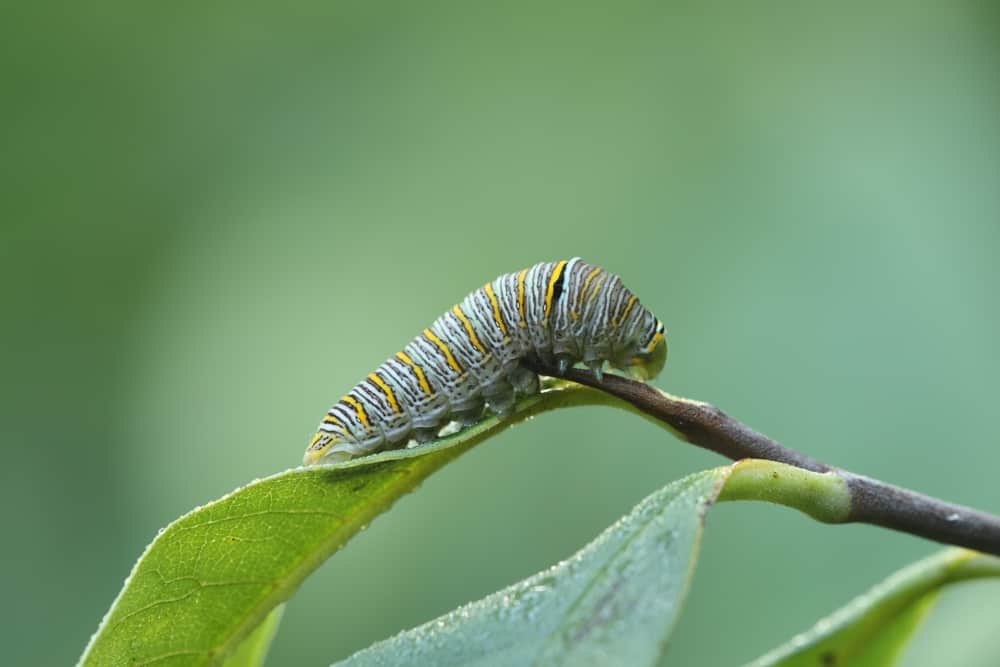
The caterpillar of the zebra swallowtail butterfly has black eyes with yellow pupils.
©Kevin Collison/Shutterstock.com
The zebra swallowtail caterpillar in Oklahoma undergoes a captivating life cycle. It initiates as an egg, delicately placed on the lush foliage of a host plant, such as a citrus tree or lilac bush. Upon hatching, the tiny caterpillar wastes no time and eagerly consumes the nourishing leaves of its host. As it matures, the caterpillar gracefully molts, shedding its skin multiple times. Distinguished by its distinctive black and yellow stripes, the zebra swallowtail caterpillar possesses unique horn-like projections on its body. Called osmeterium, they serve as a defense mechanism against potential predators by releasing a bad taste.
7. Two-Tailed Swallowtail Caterpillar (Papilio multicaudata)

When two-tailed swallowtail caterpillars eat leaves, they fold and tie them up with silk.
©Whitney Cranshaw, Colorado State University, Bugwood.org / CC BY 3.0 US – License
The two-tailed swallowtail caterpillar is no stranger to the grasslands and meadows of western Oklahoma. It measures approximately 2 inches in length, with an orange-brown or bright green body exhibiting a mottled black and white coloration. As it gets older, the caterpillar develops a unique pattern on its thorax that looks like a pair of eyes, which confuses predators. This voracious eater consumes a substantial number of leaves in a relatively short span of time, primarily feasting on ash trees, hop trees, and chokecherries. After a period of approximately four weeks, the two-tailed swallowtail caterpillar strategically seeks a secure spot, often attaching itself to a branch or leaf, and proceeds to spin a silken cocoon. Inside this protective enclosure, a marvelous metamorphosis takes place, culminating in the emergence of a stunning butterfly.
8. Cabbage Worm Caterpillar (Pieris rapae)
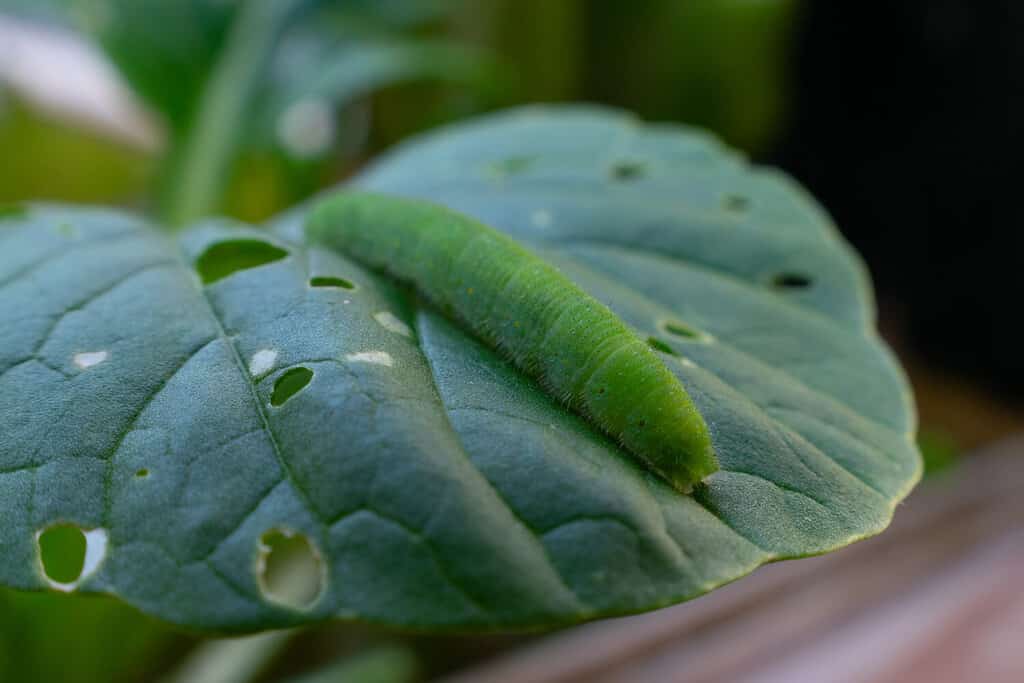
Cabbage worms are considered pests in many areas because they eat so much.
©Kelsey Armstrong Creative/Shutterstock.com
With vibrant green and blue-green colors, cabbage worm caterpillars are common pests in Oklahoma. Also known as cabbage white butterfly caterpillars, they eat the leaves of cauliflower, broccoli, brussels sprouts, and cabbage, which makes them a problem for many farmers. They transform into delicate cabbage white butterflies with snow-white wings speckled with black markings. The butterflies lay their tiny eggs on the undersides of leaves, and the voracious caterpillar pupae eat for 10 to 14 days before entering into a chrysalis.
Poisonous Caterpillars Found in Oklahoma
Some caterpillars found in Oklahoma can be poisonous due to their defensive adaptations. Indigo caterpillars, hairy caterpillars, and milkweed caterpillars, for example, are fascinating caterpillar groups with unique predator defenses. Indigo caterpillars possess a poisonous substance that acts as a powerful deterrent, while hairy caterpillars sport dense and prickly hairs that are irksome to potential predators. Milkweed caterpillars, on the other hand, have developed poisonous spines along with vibrant colors as a warning sign. These remarkable adaptations make all three types of caterpillars formidable adversaries to would-be attackers. Now, let’s learn about some of these little poisonous guys!
9. Puss Caterpillar (Megalopyge opercularis)

The fuzzy puss caterpillar is capable of inflicting a painful sting.
©Chase D’animulls/Shutterstock.com
The puss caterpillar is a poisonous moth caterpillar native to the Americas. This fuzzy and segmented creature typically measures around 1 to 2 inches in length. While its coloration usually spans from brown to gray, variations in black and yellow can also occur. Notably, it derives its name from the venomous spines that envelop its body. These spines carry a toxin capable of inflicting a painful sting. The life cycle of the puss caterpillar starts when the female moth lays her eggs on a host plant. Once hatched, the caterpillars feast on the leaves of the plant. After approximately four weeks, the caterpillars enter the pupal stage. Around two weeks later, the pupae transform into moths.
10. Io Moth Caterpillar (Automeris io)
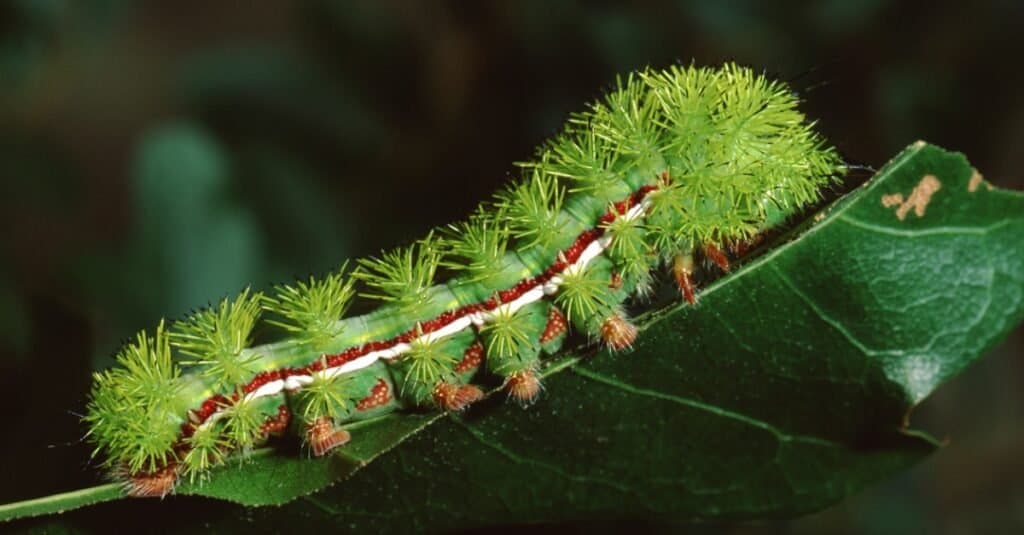
The caterpillar starts with a reddish-brown body, which becomes yellow-brown until it is a vibrant green.
©iStock.com/Weber
The Io moth caterpillar is a beautiful and venomous caterpillar found in North America. When it reaches it is mature, it is about 1 to 2 inches long and has a bright green body with a long white and red stripe and tufts of spines. The caterpillar is well-known due to its poisonous spines, which can cause a painful sting. While the caterpillar’s spines contain a toxin that may cause skin irritation, it poses no significant harm to humans. During the fall, the Io moth caterpillar undergoes pupation, transforming into a magnificent moth come spring. This large, striking creature boasts a wingspan of up to 3 inches. Adorned in vibrant shades of orange and black, it is further enhanced by the presence of captivating eyespots on its wings.
11. Saddleback Caterpillar (Sibine stimulea)

The saddleback caterpillar is a species native to North America and Mexico.
©Hagit Berkovich/Shutterstock.com
The saddleback caterpillar is a fascinating venomous caterpillar native to eastern North America. With a length of approximately 1 to 2 inches, this little creature showcases a captivating dark body, accentuated by a bright green and white saddle-shaped mark on its back. In addition, knob-like projections adorn the caterpillar’s small body, which are each covered with spines. A fact that makes this creature truly intriguing, however, is its poisonous spines, which deliver a painful sting upon contact. It serves as a testament to the diverse and awe-inspiring wonders of nature that exist right in our own backyard.
12. Milkweed Tussock Caterpillar (Euchaetes egle)
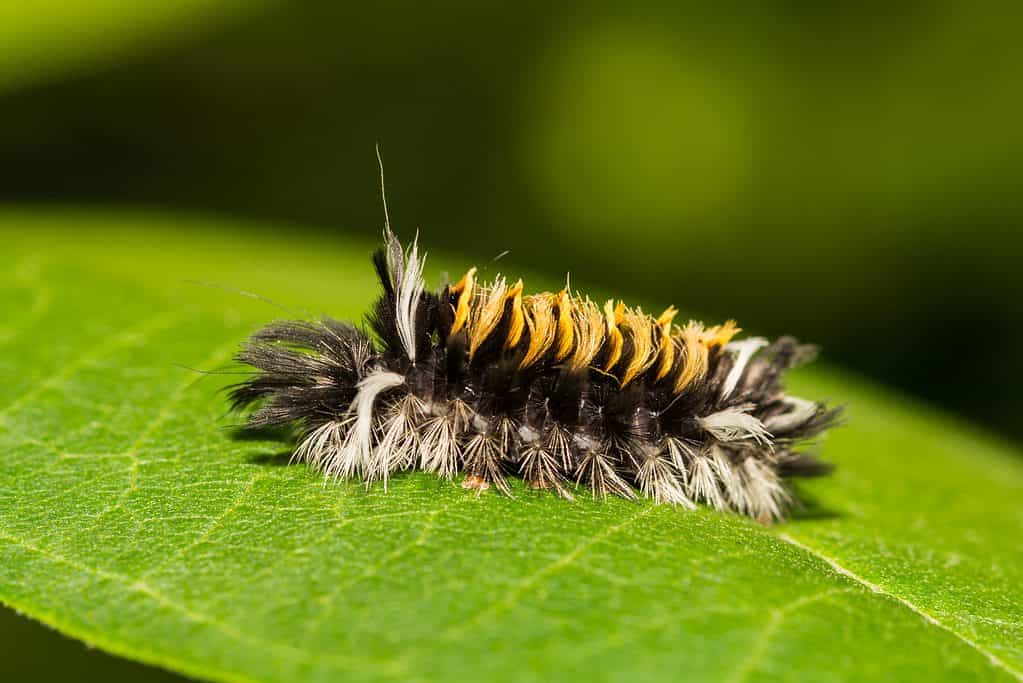
This resilient creature thrives in various habitats, from sprawling fields to serene meadows and gardens.
©Jay Ondreicka/Shutterstock.com
The milkweed tussock moth caterpillar (also known as the milkweed tiger moth) is a familiar sight in North America, captivating with its distinctive features. Spanning 1 to 2 inches, this caterpillar boasts a gray and black body adorned with captivating tufts of orange, white, and black hairs. While not venomous, the caterpillar’s tiny hairs do hold the potential to cause skin irritation if touched. Its diet predominantly centers around milkweed leaves, although it possesses the flexibility to feast upon other plants like dogbane and butterfly weed. Like other milkweed caterpillars, these plants help protect it from predators by developing a poisonous concoction within its tiny body. Come fall, the caterpillar undergoes a transformative process, pupating until spring emerges, granting it the wings of a magnificent moth. Displaying a stunning tapestry of whites, yellows, and browns on its body and grayish wings, this moth poses no threats to human beings.
13. Hag Moth Caterpillar (Phobetron pithecium)
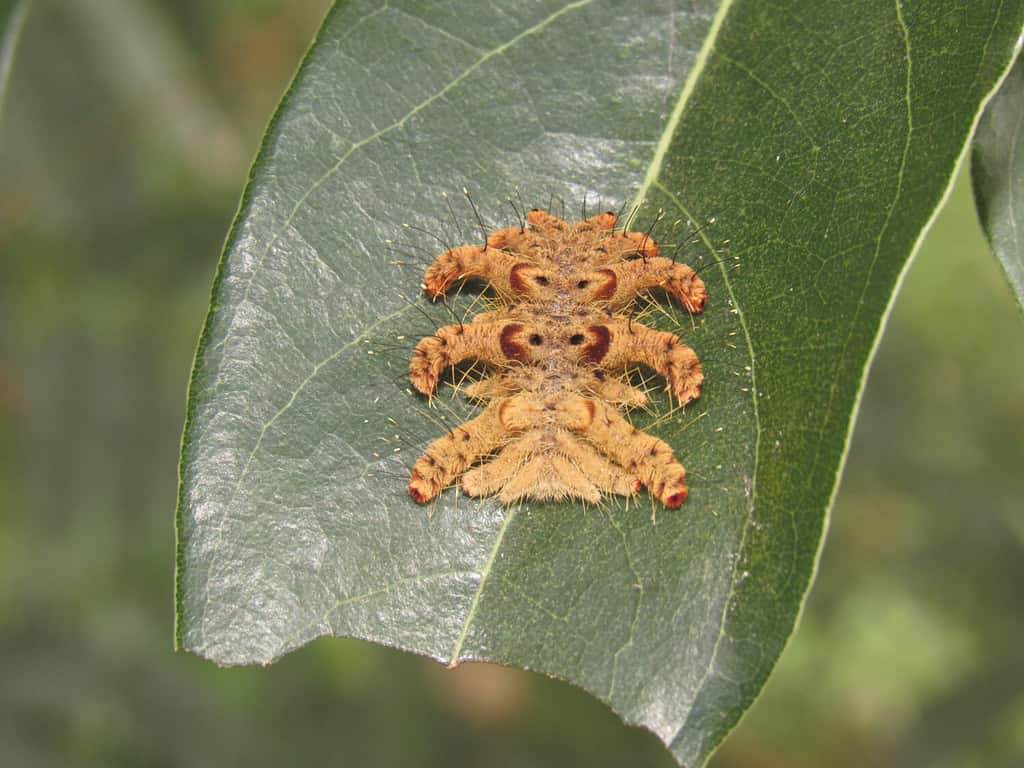
The hag moth caterpillar inhabits wooded areas, gardens, and various vegetated spaces.
©Fabio Ara/Shutterstock.com
Encountering a hag moth caterpillar is an unmistakable experience. These remarkable caterpillars, measuring approximately 1 inch in length, possess a distinctive appearance akin to a monkey’s face. Sporting dark brown bodies adorned with yellow stripes and black horns resembling monkey ears, they become truly intriguing denizens of Oklahoma’s wildlife. This unique appearance is why many people call them “monkey slugs”. The monkey slug caterpillar, native to Oklahoma is typically found in the eastern half of the state. Although the monkey slug caterpillar is generally harmless to humans, it’s important to be cautious as its tiny hairs can cause irritation in certain individuals.
14. Monarch Butterfly Caterpillar (Danaus plexippus)

The monarch butterfly caterpillar feeds on milkweed.
©iStock.com/CathyKeifer
In the breathtaking landscapes of Oklahoma, the majestic monarch butterfly graces us with their presence, especially during the enchanting fall migration. It’s captivating to witness these incredible creatures embark on their remarkable journey from the eastern regions, including Oklahoma, all the way to the splendid mountains of central Mexico. As they begin their awe-inspiring northward migration in the spring, Oklahoma becomes a vital stop for these magnificent beings. Here, they replenish their energy by feasting on milkweed plants and delighting in the sweet nectar. Although harmless to humans, monarch caterpillars and butterflies are poisonous to other animals due to the toxins from the milkweed plants they eat.
15. Spiny Oak Slug (Euclea delphinii)
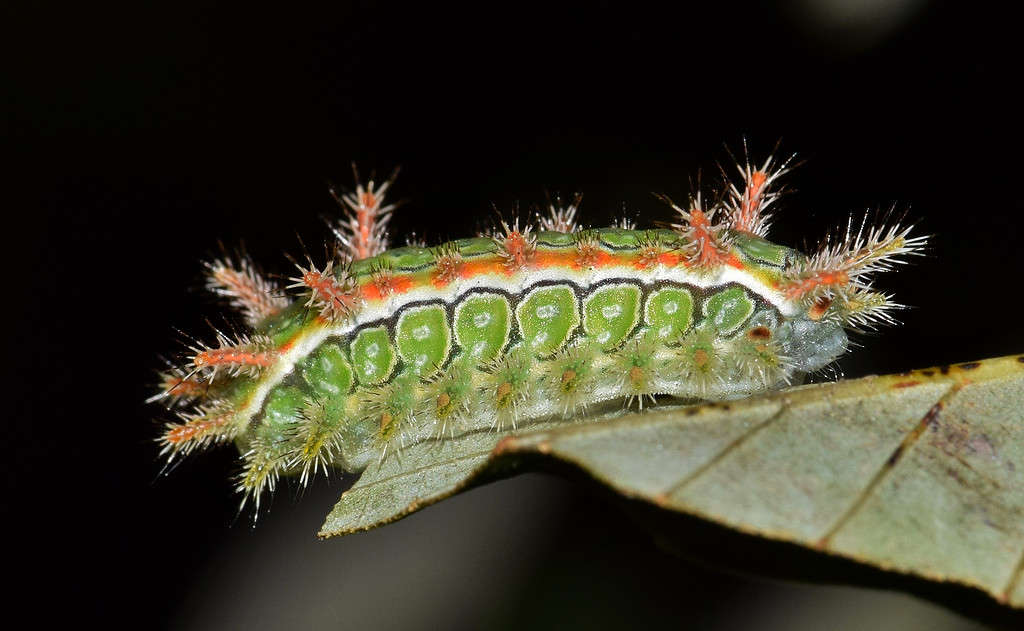
Spiny oak slug caterpillars cause an itchy or burning sensation and inflammation at the point of contact.
©Brett_Hondow/iStock via Getty Images
The spiny oak slug is mostly green, with brown, yellow, pink, or red markings. It boasts a unique, flat oval shape, adorned with spiky bumps that serve as both its distinctive feature and its defense mechanism. It’s crucial to note that these bumps are venomous, potentially eliciting various reactions in humans, ranging from itching and burning to more severe symptoms that warrant medical attention. As it matures, it may sprout two to four sets of fascinating black hairs at the end of its body, which can ultimately detach. True to its family, the spiny oak slug possesses an intriguing anatomical configuration, with short legs and suction cups in place of typical feet.
Summary of Caterpillars Found in Oklahoma
Swallowtail Caterpillars
| Common Name | Scientific Name |
|---|---|
| Black Swallowtail Caterpillar | Papilio polyxenes |
| Eastern Tiger Swallowtail Caterpillar | Papilio glaucus |
| Giant Swallowtail Caterpillar | Papilio cresphontes |
| Pipevine Swallowtail Caterpillar | Battus philenor |
| Spicebush Swallowtail Caterpillar | Papilio troilus |
| Zebra Swallowtail Caterpillar | Protographium marcellus |
| Two-Tailed Swallowtail Caterpillar | Papilio multicaudata |
| Cabbage Worm Caterpillar | Pieris rapae |
Poisonous Caterpillars
| Common Name | Scientific Name |
|---|---|
| Puss Caterpillar | Megalopyge opercularis |
| Io Moth Caterpillar | Automeris io |
| Saddleback Caterpillar | Sibine stimulea |
| Milkweed Tussock Caterpillar | Euchaetes egle |
| Hag Moth Caterpillar | Phobetron pithecium |
| Monarch Butterfly Caterpillar | Danaus plexippus |
| Spiny Oak Slug | Euclea delphinii |
The photo featured at the top of this post is © Karel Bock/Shutterstock.com
Thank you for reading! Have some feedback for us? Contact the AZ Animals editorial team.







